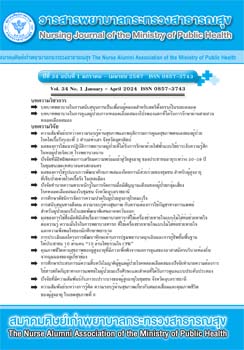Factors Relating to Frailty among community-dwelling Elderly in Ubon Ratchathani Province
Main Article Content
Abstract
Frail older people have a high risk of premature death, serious illness, and delayed recovery. However, if frailty is detected in the beginning and managed appropriately, it can be preventable and slowly progress. The purposes of this descriptive correlation study were to examine the prevalence of frailty and factors relating to frailty in community-dwelling elderly. One hundred and forty-eight participants were recruited from the community-dwelling elderly in the Ubon Ratchathani Province by multi-stage sampling. Data were collected by questionnaires to assess personal information, frailty, and health literacy. Data were analyzed using descriptive statistics and binary logistic regression analysis. The results revealed that 46.60% of the participants had frailty syndrome, while 31.80% of them was pre-frail, and 21.60% was non-frail. Regarding the factors relating to frailty among the elderly in this study, it was found that age and gender were statistically significant factors. Therefore, interventions to prevent or reduce the level of frailty in community-dwelling older adults should be implemented for each group of them in order to improve a good quality of life and promote their independence.
Article Details

This work is licensed under a Creative Commons Attribution-NonCommercial-NoDerivatives 4.0 International License.
บทความและรายงานวิจัยในวารสารพยาบาลกระทรวงสาธารณสุข เป็นความคิดเห็นของ ผู้เขียน มิใช่ของคณะผู้จัดทำ และมิใช่ความรับผิดชอบของสมาคมศิษย์เก่าพยาบาลกระทรวงสาธารณสุข ซึ่งสามารถนำไปอ้างอิงได้
References
National Statistical Office. The 2021 surver of The older persons in Thailand. Bangkok: Ministry of Digital Economy and Society;2022.(in Thai)
Institute of Geriatrics Department of Medical Services, Ministry of Public Health. Guidelines for geriatric syndromes care. Nonthaburi: IS AUGUST;2015.(in Thai)
Fried LP, Tangen CM, Walston J, Newman AB, Hirsch C, Gottdiener J, et al. Frailty in older adults: evidence for a phenotype. The Journals of Gerontology Series A Biological Sciences and Medical Sciences. 2001;56(3):146-57.
Chen LJ, Chen CY, Lue BH, Tseng MY, Wu SC. Prevalence and associated factors of frailty among elderly people in Taiwan. International Journal of Gerontology 2014;8(3):114-9.
Jaidee S, Sasat S. A study of frailty in older people resided in community, Bangkok. Royal Thai Navy Medical Journal 2017;44(3):117-35.(in Thai)
Huang CH, Lai YC, Lee YC, Teong XT, Kuzuya M, Kuo KM. Impact of health literacy on frailty among community-dwelling seniors. Journal of Clinical Medicine 2018;7(12):418-28.
Smith SG, O’Conor R, Curtis LM, Waite K, Deary IJ, Paasche-Orlow M, et al. Low health literacy predicts decline in physical function among older adults: findings from the LitCog cohort study. Journal Epidemiology and Community Health 2015;69(5):474–80.
Shirooka H, Nishiguchi S, Fukutani N, Adachi D, Tashiro Y, Hotta T, et al. Association between comprehensive health literacy and frailty level in community-dwelling older adults: A cross-sectional
study in Japan. Geriatrics and Gerontology International 2017;17(5):804-9.
Roojanavech S, Chatdokmaiprai K. The effects of health literacy development program with family participation of overweight primary school students in Nakhon Pathom Province. Royal Thai Navy Medical Journal 2020;48(3):591-610.(in Thai)
Ginggeaw S, Prasertsri N. The relationship between health literacy and health behaviors among older adults who have multi-morbidity. Nursing Journal of the Ministry of Public Health 2016;25(3):43-54. (in Thai)
Polit GF, Hungler BP. Nursing research principles and medthod. 6th ed. Philadelphia: Lippincott;1999.
Institute of Geriatric medicine. Mini-mental state examination–Thai version 2002 (MMSE-Thai 2002). Bangkok: Ministry of Public Health;1999.(in Thai)
Intarakamhang U. Creating and developing of Thailand health literacy scales. Bangkok: Behavioral Science Research Institute (BSRI), Srinakharinwirot University;2017.(in Thai)
Boribun N, Lerttrakarnnon P, Siviroj P. Prevalence and associated factors of the frailty among community-dwelling elders in Sermngam district, Lampang province. Journal Medicine and Health Sciences 2017;24(1):45-54.(in Thai)
Runzer-Colmenares FM, Samper-Ternent R, Al Snih S, Ottenbacher KJ, Parodi JF, Wong R. Prevalence and factors associated with frailty among Peruvian older adults. Archives of Gerontology and Geriatrics 2014;58(1):69-73.
Netchan P, Thato R, Sasat S. Selected factors related to frailty older persons in public residential home. Journal of The Police Nurses 2019;11(1):61-72.(in Thai)
Suwanpasu S. Aging, deficit accumulation and frailty. In: Praditpornsilpa K, editor. Textbook of geriatric medicine. Bangkok: Rungsilp Printing (1977);2018.35-51.(in Thai)
Ng TP, Feng L, Nyunt MSZ, Larbi A, Yap KB. Frailty in older persons: multisystem risk factors and the frailty risk index (FRI). Journal of the American Medical Directors Association 2014;15(9):635-42.
Kaeodumkoeng K, Thummakul D. Health literacy promoting in aging population. Journal of health science research 2015;9(2):1-8.(in Thai)

